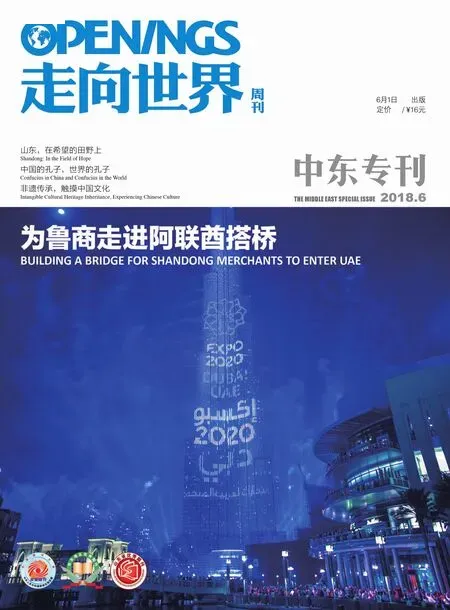运河两岸:赴一场千年之约
2018-06-22肖寒
文/肖寒

○台儿庄古城内遍布水街水巷,可以舟楫摇曳、遍游全城。图为古城内的步云廊桥。图/高启民In the Old Town of Taierzhuang, there are water streets and alleys everywhere. Visitors may take a boat to travel around the town. The picture depicts the Buyun Gallery Bridge in Taierzhuang.
公元前486年,吴王夫差为争霸中原,以水路沟通江淮,下令“开邗沟,筑邗城”,从此开启了大运河2500年的航程。
作为世界上最长、最古老的人工水道,京杭大运河全长1797公里,像一条纵贯南北的大动脉,也缓缓流淌过齐鲁大地。如今,在运河两岸那些烟雨中的楼台、清晰可识的古迹、复始的驳船……一切都恍如隔世。站在古运河的堤岸上,恰如赴一场跨越千年的约见。
山东境内之运河全长510.6公里,是京杭大运河中海拔最高、船闸密度最大、水利工程成就最集中的河段。先是由北南下至德州,京杭大运河德州段从德州市区及武城、夏津境内穿过,造就了诸多令人赞叹的古迹。细数之来,四女寺镇尤为惹眼,因汉朝“四女孝亲”的故事传说而闻名,是当时卫运河上的重要码头,常年商贾云集,繁华非常。
由运河乘船顺流南下,便是著名的“江北水城”——聊城。全长97.5公里的大运河聊城段,不仅带动了聊城经济的发展,还在这片沃土上积淀下丰厚的运河文化遗产。登上位于聊城旧城中央的光岳楼之顶,水城之美便尽收眼底。风光秀丽的东昌湖环绕聊城古城一周,为这座城市增加了灵气,一座座青砖灰瓦小院勾划出了平和安静的宁祥与质朴之美。
而位于聊城东关古运河西岸的山陕会馆却是由繁荣的旧时造就而出的奇迹。清乾隆年间,京杭大运河漕运畅通,聊城的商业尤为繁盛,于是山、陕商人便于公元1743年造建了山陕会馆,作为其商贾集会宴游与奉祀关帝的处所。
“南有苏杭,北有临张”,这是人们对京杭大运河沿岸四处著名商埠的表述,而其中的“临”即为山东临清。大运河造就了古代临清的富庶繁荣,至今仍保持着旧有城市的繁华肌理,运河钞关、鳌头矶、清真寺等是弥足珍贵的运河文化遗存。
京杭大运河泰安东平段,是整个京杭大运河的心脏所在,而之所以称之为心脏是因为这里的一座入选世界文化遗产的“戴村坝”。戴村坝距今已有600年的历史,是整个大运河提供调水的重要水利设施,有“中国第二都江堰”之称。
顺流而下,古老的济宁运河段区几经整修,皆用青石垒砌,别具一番诗情画意。大运河水滋润着悠悠的微山湖,也拥抱着南阳古镇。元代南北大运河通航后,皇帝走水路南巡必经南阳并在此停居。穿行在运河商埠之地的街巷中,似乎也穿越了历史。
作为京杭大运河唯一一段东西走向的航道,枣庄段运河从微山湖烟波浩淼的东口,蜿蜒向东流经鲁南大地进入江苏入中运河,造就了十里港湾不夜城。这个城市的台儿庄古城拥有运河上保存完整的遗产体系——3公里长的古运河河道,被称为“活着的运河”。作为运河文化的承载体,台儿庄古城也是二战遗存最多的抗战名城。江北水乡,运河古城,英雄台儿庄这些尘封的印记,唤醒着这座城市对世界文化遗产的保护和传承。
编辑/王雪芃

○大运河穿镇而过为南阳古镇的街面造就了独特的景观。图/何康The Grand Canal flows through the town and forms the unique scene for the street of Nanyang ancient town.

○古时的四女寺镇是京杭大运河德州段重要的码头,常年商贾云集。图/武城县文体广电新闻出版局提供In the ancient times, Sinusi Town was an important wharf in the Dezhou section of the Grand Canal, where merchants gathered throughout the year.
In 486 BC, King Fuchai of Wu ordered his men to “open up the Hangou Canal and build the Han City” to connect the Yangtze River with the Huai River, for the purpose of achieving hegemony in the Central Plains, and thus started the 2500-year voyage of the Grand Canal.
As the world’s longest and oldest artificial watercourse, the Beijing-Hangzhou Grand Canal has an overall length of 1,797km. Like a main artery of communications between north and south, it slowly flows through Shandong. Nowadays, the buildings in the misty rain, the clearly visible historical sites, the boats moving in circles, and the like on both banks of the Grand Canal seem not to have changed much. Standing on the embankment of the Grand Canal, you may feel as if keeping an appointment across the millennia.
W i t h a n o v e r a l l l e n g t h o f 510.6km, the Shandong section of the Grand Canal is the section with the highest elevation, the largest navigation lock density and the most centralized achievements in hydraulic engineering. It first flows to Dezhou from north to south. The Dezhou section flowing through the urban area of Dezhou, Wucheng and Xiajin has created numerous amazing historical sites. Among them, Sinushi Town is particularly conspicuous.Famous for the legend of “Four Daughters with Filial Piety”, it was an important wharf on the Wei Canal.With many merchants gathering here throughout the year, it was fairly prosperous.

○台儿庄保存完好的3公里明清时期古运河遗迹。图/高启民The well-preserved 3km ancient canal of the Ming and Qing Dynasties in Taierzhuang.
After going downstream by ship on the canal, you will reach the famous “Jiangbei Watertown” –Liaocheng. With an overall length of 97.5km, the Liaocheng section has not only promoted the economic development of Liaocheng, but also accumulated rich canal heritage on the fertile land. Ascending the top of Guangyue Tower in the center of the Old Town of Liaocheng, you will have a panoramic view of the beauty of the Watertown. The Old Town of Liaocheng is surrounded by the beautiful Dongchang Lake, which adds spirituality to this city. Those courtyards made of black bricks and grey tiles outline tranquility and the beauty of simplicity.
The Shanxi-Shaanxi Guildhall located on the west bank of the Dongguan Ancient Canal of Liaocheng is a miracle created by the past prosperity. In the Qianlong Period of the Qing Dynasty, the Grand Canal enjoyed unimpeded transportation,and the business of Liaocheng was particularly thriving. Thus, in 1743,the Shanxi and Shaanxi merchants built the Shanxi-Shaanxi Guildhall as a place for gatherings and banquets of merchants and worship of Guan Yu.
“In the south, there is Suzhou and Hangzhou; in the north, there is Linqing and Zhangqiu.” It represents four famous commercial ports along the Grand Canal. Among them,“Lin” refers to Linqing, Shandong.The Grand Canal contributed to the aff l uence and prosperity of Linqing in ancient times. Today, it still maintains its original thriving texture. The Canal Customs Post, Aotouji, Mosque, and so forth are precious remains of the canal culture.
The Dongping section in Tai’an is the heart of the Grand Canal, because there is “Dai Village Dam” which is included in the list of world cultural heritage. With a history of 600 years,Dai Village Dam is an important water conservancy facility for providing water diversion on the Grand Canal,known as the “Second Dujiangyan of China”.
Flowing downstream, the ancient Jining section has been renovated with limestone several times. It appears poetic and picturesque. The canal water nourishes the Weishan Lake, and embraces the Old Town of Nanyang. After the North-South Grand Canal was opened to navigation in the Yuan Dynasty, Nanyang became an essential stop on the emperor’s southern tour by water, and the emperor often stayed in Nanyang for some days. Walking down the streets and alleys in the commercial port of the Grand Canal, you may feel like traveling across history.
As the sole east-west channel of the Grand Canal, the Zaozhuang section flows from the misty East Estuary of the Weishan Lake, winding its way eastwards to the Zhong Canal after entering Jiangsu by way of Southern Shandong. In this way, it enables the town by the canal to have no darkness all the time. The Old Town of Taierzhuang has a wellpreserved heritage system on the canal – the 3km-long ancient canal channel, which is known as a “Living Canal”. As a carrier of the canal culture, the Old Town of Taierzhuang is also a famous Anti-Japanese War town with the largest quantity of remains of World War II. Such dustladen imprints as the Jiangbei Watertown, the Old Town of the Grand Canal and heroic Taierzhuang arouse the protection and inheritance of world cultural heritage in the city.
